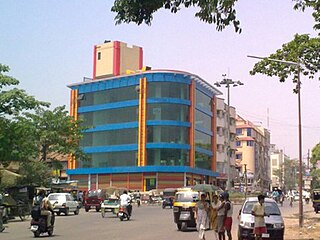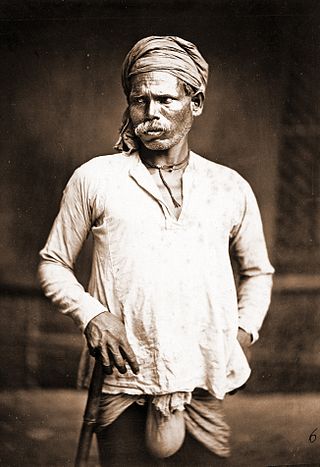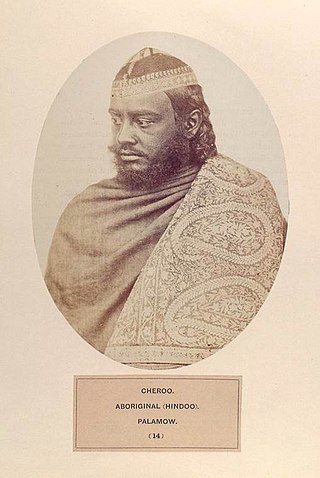
East Singhbhum is one of the 24 districts of Jharkhand, India. It was created on 16 January 1990. More than 50% of the district is covered by dense forests and mountains, where wild animals once roamed freely. It is known for being a centre of industry since Jamshedpur, the most populous city in Jharkhand, is located here.

West Singhbhum or Pashchimi Singhbhum is one of the 24 districts of Jharkhand state, India. It came into existence on 16 January 1990, when the old Singhbhum district was bifurcated. Chaibasa is the district headquarters.

Seraikela-Kharsawan district or Saraikella and Kharaswan district is one of the twenty-four districts of Jharkhand state in eastern India. Seraikela town is the district headquarters of Saraikela Kharsawan district. The district is well known for Seraikela Chhau, one of the three distinctive styles of the chhau dance. This district was carved out from West Singhbhum district in 2001. The district was formed from the princely states of Seraikela and Kharaswan, after the independence of India.

The Dom, also known as Domra, Domba, Domaka, Dombara and Dombari, are castes, or groups, scattered across India. Dom were a caste of drummer. According to Tantra scriptures, the Dom were engaged in the occupations of singing and playing music. Historically, they were considered an untouchable caste called the Dalits and their traditional occupation was the disposal and cremation of dead bodies. They are in the list of Scheduled caste for Reservation in India in the Indian states of Uttar Pradesh, Bihar, Odisha, Andhra Pradesh, Jharkhand and West Bengal.

The Munda people are an Austroasiatic-speaking ethnic group of the Indian subcontinent. They speak Mundari as their native language, which belongs to the Munda subgroup of Austroasiatic languages. The Munda are found mainly concentrated in the south and East Chhotanagpur Plateau region of Jharkhand, Odisha and West Bengal. The Munda also reside in adjacent areas of Madhya Pradesh as well as in portions of Bangladesh, Nepal, and the state of Tripura. They are one of India's largest scheduled tribes. Munda people in Tripura are also known as Mura.

The Baiga are an ethnic group found in central India primarily in the state of Madhya Pradesh, and in smaller numbers in the surrounding states of Uttar Pradesh, Chhattisgarh and Jharkhand. The largest number of Baiga is found in Baiga-chuk in Mandla district and Balaghat district of Madhya Pradesh. They have sub-castes: Bijhwar, Narotia, Bharotiya, Nahar, Rai maina and Kath maina. The name Baiga means "sorcerer-medicine man".

Purulia district is one of the twenty-three districts of West Bengal state in Eastern India. Purulia is the administrative headquarters of the district. Some of the other important towns of Purulia district are Raghunathpur-Adra, Jhalda, Anara and Balarampur.

Kendujhar District, is an administrative district of Odisha. The district is one of the fifth Scheduled Areas of Odisha. The town of Kendujhar is the district headquarters. The district has three sub-divisions, Anandapur, Champua, and Kendujhar.
Bauri (Bengali:বাউরী) is a community of indigenous people primarily residing in Bengal, and considered as one of the Scheduled Castes of India. The Bauris belong to the Bhil tribe. They are usually involved in activities like farming. The Bauris of Purbo Tila Moulvibazar in Bangladesh are usually involved in medicinal practices. The prime festivals they celebrate are known as Mansa Puja, Durga Puja and Kali Puja.

Bhumij is a Munda ethnic group of India. They primarily live in the Indian states of West Bengal, Odisha, Assam and Jharkhand, mostly in the old Singhbhum district. Also in states like Bihar and Assam. There is also a sizeable population found in Bangladesh. Bhumijas speak the Bhumij language, an Austroasiatic language, and use Ol Onal script for writing.
The Lal Begi, or Lalbegi, are a Chuhra caste found in the states of Bihar and Uttar Pradesh in India, as well as in Multan, Dera Ghazi Khan and Bahawalpur in Pakistan.

The Chero is a caste found in the states of Bihar, Jharkhand and Uttar Pradesh in India.
The Parahiya are a Hindu caste found in the state of Uttar Pradesh in North India.

Musahar or Mushahar are a Dalit community found in the eastern Gangetic plain and the Terai. They are also known as Rishidev, Sada, Manjhi, Banbasi. The other names of the Musahar are Bhuiyan and Rajawar. there are many who are still forced to do this work due to destitution and poverty.
Kharwar is a community found in the Indian states of Uttar Pradesh, Bihar, Jharkhand, Chhattisgarh, Orissa and West Bengal.
The Bedia are a community in India. They believe that they originally lived on Mohdipahar of Hazaribagh district and have descended from the union of Vedbansi prince with a Munda girl. A legend has heard that they had their own 'Vedas' and hence it is called Bediya. Their Veda was different from the Vedas of Aryans, which were destroyed by the Aryans
The Kapariya are Hindu caste found in the state of Uttar Pradesh in India. They are also known as Khunkhuniya Bhatt and are listed as a Scheduled Tribe.
The Khairaha are a Hindu caste found in the state of Uttar Pradesh in India. They have Scheduled Caste status.
The Patari are a community found mainly in the Sonbhadra district of Uttar Pradesh, India.
Rajwar or Rajuar is a shifting cultivation community. The people of this community mainly live in Bihar, Jharkhand, Madhya Pradesh, Odisha and West Bengal. In Odisha, they are recognized as a Scheduled Tribe, while in Bihar, Jharkhand, and West Bengal, they are classified as Scheduled Caste. In other states, the community is considered part of the Other Backward Classes (OBC) or general population.












